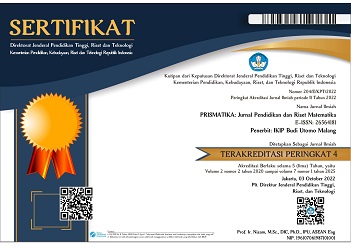KEMAMPUAN BERPIKIR KREATIF SISWA DALAM MENYELESAIKAN MASALAH KONTEKSTUAL SISTEM PERSAMAAN LINEAR DUA VARIABEL BERBANTUAN GEOGEBRA
Abstract
The purpose of this study is to describe students' ability to think creatively when facing SPLDV problems in certain contexts using the help of Geogebra. This research is qualitative research that uses the case study method to deeply understand students' creative thinking abilities. Two grade VIII junior high school students with varying initial ability levels of SPLDV were the subjects of this study. The instruments used include the SPLDV initial ability test, creative thinking ability test using Geogebra, and interview guidelines. The creative thinking test consists of four question points that measure indicators of fluency, flexibility, and novelty, with a completion time of 45 minutes. The results showed that students with high abilities could achieve the creative category (TKBK 3) because they were able to meet all indicators of fluency and novelty. Students can provide various alternative answers and use various logical strategies in solving problems. On the other hand, students with low abilities tend to fall into the less creative category (TKBK 1) because they can only meet the fluency indicator. Although subjects can provide a variety of alternative answers that are appropriate, they have not been able to describe the use of diverse strategies in solving problems.
References
Avivah, N., & Faiziyah, N. (2023). Analisis kemampuan berpikir kreatif siswa dalam menyelesaikan soal multiple solution task ditinjau dari gaya belajar. Math Didactic: Jurnal Pendidikan Matematika, 9(2), 247–263. https://doi.org/10.33654/math.v9i2.2159
Ayuningtyas, D. A., Darminto, B. P., & Purwaningsih, W. I. (2017). Analisis Kemampuan Berpikir Kreatif Siswa Dalam Menyelesaikan Spldv Berdasarkan Kemampuan Matematika.
Bachore, M. M. (2021). The Influence Of Learning Mathematics Software Geogebra On The Ability Of Creative Thinking Of Students. International Journal Of Humanities Education and Social Sciences (IJHESS), 1(1), 37–42. https://doi.org/10.55227/ijhess.v1i1.35
Dilekçi, A., & Karatay, H. (2023). The effects of the 21st century skills curriculum on the development of students’ creative thinking skills. Thinking Skills and Creativity, 47, 101229. https://doi.org/10.1016/j.tsc.2022.101229
Farihah, U., Rachmawati, N., & Hariati, A. (2022). Pengaruh Media Interaktif Geogebra Terhadap Kemampuan Menyelesaikan Soal Cerita Matematika Pada Materi SPLDV. AKSIOMA: Jurnal Program Studi Pendidikan Matematika, 11(4), 2985. https://doi.org/10.24127/ajpm.v11i4.5948
Hadar, L. L., & Tirosh, M. (2019). Creative thinking in mathematics curriculum: An analytic framework. Thinking Skills and Creativity, 33, 100585. https://doi.org/10.1016/j.tsc.2019.100585
I. Casing, P., & B. Roble, D. (2021). Students’ Mathematical Creative Thinking Ability with Posing-Exploring-Doing-Evaluating (PEDE) Productive Failure Model in New Normal. American Journal of Educational Research, 9(7), 443–448. https://doi.org/10.12691/education-9-7-8
Inayah, S., Ariyanto, L., & Endahwuri, D. (2021). Analisis kemampuan pemecahan masalah dalam menyelesaikan soal pada materi SPLDV ditinjau dari kemampuan berpikir kreatif siswa.
Kadir, I. A., Machmud, T., Usman, K., & Katili, N. (2022). Analisis Kemampuan Berpikir Kreatif Matematis Siswa Pada Materi Segitiga. Jambura Journal of Mathematics Education, 3(2), 128–138. https://doi.org/10.34312/jmathedu.v3i2.16388
Keengwe, J., & Byamukama, R. (Eds.). (2019). Handbook of Research on Promoting Higher-Order Skills and Global Competencies in Life and Work: IGI Global. https://doi.org/10.4018/978-1-5225-6331-0
Murwaningsih, W. I. (n.d.). ANALISIS KEMAMPUAN BERPIKIR KREATIF SISWA DALAM MENYELESAIKAN SOAL SPLDV BERBANTUAN SOFTWARE GEOGEBRA BERDASARKAN KEMAMPUAN AWAL. 4.
Qadri, L., Ikhsan, M., & Yusrizal, Y. (2019). Mathematical Creative Thinking Ability for Students Through REACT Strategies. International Journal for Educational and Vocational Studies, 1(1), 58. https://doi.org/10.29103/ijevs.v1i1.1483
Siswono, T. Y. E. (2010). LEVELING STUDENTS’ CREATIVE THINKING IN SOLVING AND POSING MATHEMATICAL PROBLEM. Journal on Mathematics Education, 1(1), 17–40. https://doi.org/10.22342/jme.1.1.794.17-40
Siswono, T. Y. E. (2018). Pembelajaran Matematika Berbasis Pengajuan Masalah dan Pemecahan Masalah. PT. Remaja Rosdakarya.
Sopiah, E. S., Sunaryo, Y., & Effendi, A. (2020). Analisis Kemampuan Berpikir Kreatif Matematis Siswa Kelas Viii Pada Materi Sistem Persamaan Linear Dua Variabel (SPLDV). J-KIP (Jurnal Keguruan dan Ilmu Pendidikan), 1(2). https://doi.org/10.25157/j-kip.v1i2.4396
Suherman, S., & Vidákovich, T. (2022). Assessment of mathematical creative thinking: A systematic review. Thinking Skills and Creativity, 44, 101019. https://doi.org/10.1016/j.tsc.2022.101019
Syahara, M. U., & Astutik, E. P. (2021a). Analisis Berpikir Kreatif Siswa dalam Menyelesaikan Masalah SPLDV ditinjau dari Kemampuan Matematika. Mosharafa: Jurnal Pendidikan Matematika, 10(2), 201–212. https://doi.org/10.31980/mosharafa.v10i2.892
Syahara, M. U., & Astutik, E. P. (2021b). Analisis Berpikir Kreatif Siswa dalam Menyelesaikan Masalah SPLDV ditinjau dari Kemampuan Matematika. Mosharafa: Jurnal Pendidikan Matematika, 10(2), 201–212. https://doi.org/10.31980/mosharafa.v10i2.892
Yayuk, E., Purwanto, P., Rahman, A., & Subanji, S. (2020). Primary School Students’ Creative Thinking Skills in Mathematics Problem Solving. European Journal of Educational Research, 9(3), 1281–1295. https://doi.org/10.12973/eu-jer.9.3.1281







.png)




